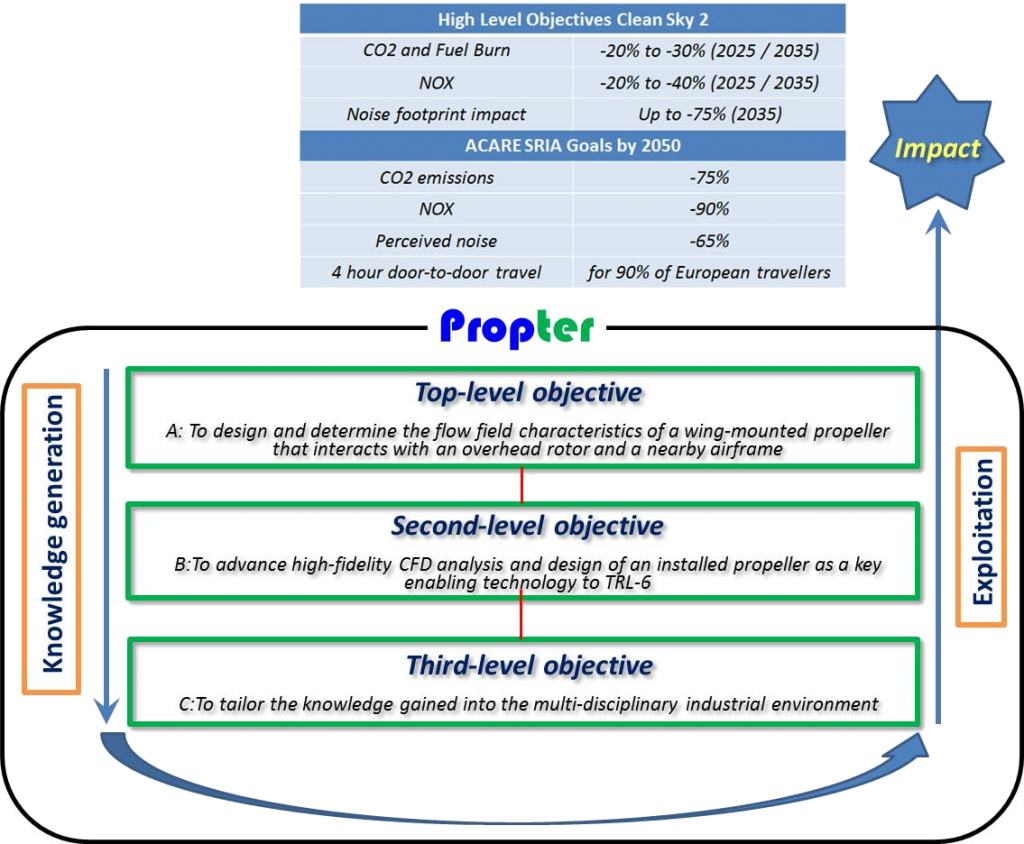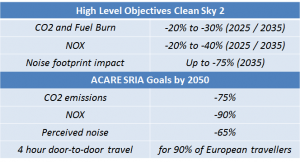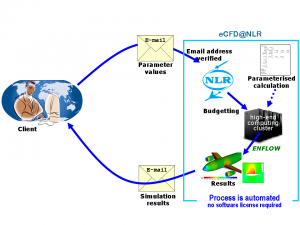PROPTER meets the challenge of Clean Sky’s Airbus RACER compound helicopter concept that opens up new mobility roles currently uncovered by neither conventional helicopters nor fixed wing aircraft in terms of payload capacity, agility in vertical flight including capability to land on unprepared surfaces nearby obstacles and to load/unload rescue personnel and victims while hovering, long range, high cruise speed, low fuel consumption and gas emission, low community noise impact, and productivity for operators.
The specific challenge to be dealt with in PROPTER is due to the compound configuration consisting of a multitude of aerodynamic surfaces: the main rotor, the two lateral rotors, the low-aspect ratio wing, and the tail planes, to deliver the forces and moments necessary for cruise, hover, auto-rotation and manoeuvres. The lateral rotors are driven by the same turboshaft engines driving the rotor. This concept aims at a step change in the efficiency and speed capability of the next generation rotorcraft.
In high-speed forward flight, the compound configuration relieves the rotor in high-speed forward flight conditions, by transferring the role of producing thrust to the lateral rotors and lift to the low-aspect ratio wing on which the lateral rotors are installed. At low speed and hover conditions, an antisymmetric pitch setting of the lateral rotor blade counters the torque generated by the rotor.
The envisioned layout leads to lateral rotor performance and control loads in an aerodynamically complex near-field around a compound helicopter configuration which necessitates a detailed analysis of the installed lateral rotor design under different operating conditions.
Project
PROPTER addresses the analysis and design of lateral rotors operating in the complex flow field around a compound helicopter where a strong interaction with airframe and lifting rotor occurs. The objectives are well-thought out to ensure (i) sound understanding of the physics of the interactional flow, (ii) appropriate advancement and deployment of high-fidelity CFD methods for obtaining high confidence results, and (iii) smooth integration of the generated knowledge into the industrial environment. These objectives are referenced throughout the project giving a coherent chain from concept to implementation formulated to achieve the main project goal: lateral rotor design optimized for implementation in a compound helicopter.

Results
Some of the project results can be seen in the following paper / events:
- Stokkermans T., Voskuijl M., Veldhuis L., Soemarwoto B., Fukari R., Eglin P., “Aerodynamic_Installation_Effects_of_Lateral_Rotors”, Presented at the AHS International 74th Annual Forum & Technology Display, Phoenix, Arizona, USA, May 14–17, 2018.
- Clean Sky Public-Private Partnership – European aeronautics research at its best: What next in Horizon Europe?
- Propeller_analysis_design_eCFD_PROPTER_flyer.
Expected Impacts
PROPTER advances and deploys high-fidelity CFD methods with the purpose to obtain high confidence results. The significance of this endeavour is illustrated by the comment from Jean-Michel Billig, the former Eurocopter’s executive vice president for research and development, during his interview with the Aviation International News at Paris Air Show 2011:
The idea to add lateral rotors to a helicopter is not new. Several compound rotorcraft have flown since the 1950s but none of them made it to the market. So why try again now? “Today’s computation and simulation capabilities are helping us a lot,” said Billig, explaining why he believes the X3 will have a more positive outcome.1
Eurocopter X3 demonstration flights have impressively illustrated the promises a compound helicopter can deliver, but a full realization of the concept in terms of
payload capacity, agility in vertical flight including capability to land on unprepared surfaces nearby obstacles and to load/unload rescue personnel and victims while hovering, long range, high cruise speed, low fuel consumption and gas emission, low community noise impact, and productivity for operators,
still requires substantiation for the best attainable lateral rotor performance installed under influence of interactional flow fields of the rotor, fuselage, low-aspect ratio wing and lateral rotor itself. The PROPTER project will imply a new definition of installed lateral rotor performance not seen before in any conventional fixed-wing aircraft applications.
Not only the best attainable lateral rotor performance at design points will be understood well after the project, but also critical conditions in the flight envelope where the lateral rotor may operate will be identified. Such an essential knowledge will accurately define the areas and degrees of freedom (i.e. the requirements) to promote first-time right optimal design.
The PROPTER project will boost the capacity to create useful innovation by advancing state-of-the-art high-fidelity CFD methodology as a key enabling technology: to design a lateral rotor that fulfills the dual role and minimizes the required engine power of the compound helicopter. Its impact promotes the achievement of the high level objectives of Clean Sky 2 and ACARE SRIA Goals by 2050

The optimum lateral rotor will bring direct environmental impacts in terms of reduced fuel burn and CO2/NOx emissions. The project will produce numerical figures for input into engine cycle analyses in order to precisely quantify the environmental impacts. The societal impact will manifest itself in a higher mobility, as a compound helicopter equipped with properly designed lateral rotors (for high flight speeds) will effectively introduce a new dimension in the intermodal passenger transport promoting the ACARE goal of door-to-door travel within 4 hours.
Businesswise, with the high-fidelity methods readied, mastered and deployed in the three years of PROPTER project, on one hand the European industry of compound helicopter will be positioned ahead of any potential competitor in terms of accuracy and turn-around time involved in the design process. On the other hand, high-confidence sharp numerical figures will support Airbus’ communication with the potential customers, as the CEO of Airbus suggested in an interview with the Aviation Week magazine2
“But we need as well to work to exchange and communicate with our customers, because this kind of helicopter would change the way they are doing business. We have observed that the introduction into market of new formulas is difficult to make and succeed, so in this second phase we want to focus on operations, customer benefits and the value it is creating,” Faury added.
Last but not least, one should not ignore that in a larger scope of lateral rotor industry, the project will also have far-reaching impacts. Lateral rotor manufacturers are abundant worldwide, even if those producing UAV-scale and model (hobby) aircraft lateral rotor are excluded. A significant portion of them are companies located at the European Union and Associated countries who can take direct benefit of the advancement in lateral rotor design methodology as an outcome of the PROPTER project.
Dissemination
The dissemination can be distinguished in various levels for:
- use within the Airbus RACER project
- use within Use within the European Union and Associated countries
- use within the world aeronautical communities
Complementary to the common means such as journal articles, papers and presentations in workshops, an innovative means of dissemination using eCFD is envisaged. eCFD, where “e” stands for email, is a software system that implements NLR’s CFD simulations as-a-service and in the cloud.

A user (client) sends input parameters values to the eCFD server at NLR. After a positive eligibility evaluation of the parameters, the server will execute a CFD simulation chain, i.e. the so-called eCFD application, which may span an entire process of grid generation, solution procedure, and generation of tables of aerodynamic numbers and flow visualization images. All these results are made downloadable to the user, wherea a notification email will be sent to tell the user how to download the results.
An appropriate dissemination effort will be spent to define an eCFD application for a generic lateral rotor aerodynamic analysis and design optimization. The input parameters may consist of the flow condition, geometric parameters and optimization parameters defining boundaries of the design space. An online seminar (webinar) for a presentation about PROPTER, and specifically about eCFD for aerodynamic analysis and design of a lateral rotor will be organized. After the webinar the participants may evaluate further the generic eCFD application at their own discretion, to get acquainted with the potential of the more advanced methodology, and decide how the PROPTER project results can be exploited to enhance their competitiveness and help their business.
Partners and Topic Leader
The PROPTER consortium consists of Netherlands Aerospace Centre NLR (coordinator) and Delft University of Technology, who are cooperating closely with the topic leader Airbus Helicopters.
Contact
For further information about the PROPTER project please contact:
Dr. ir. Bambang I. Soemarwoto
Department Flight Physics and Loads
Netherlands Aerospace Centre NLR
Anthony Fokkerweg 2
1059 CM Amsterdam
The Netherlands
Email: bambang.soemarwoto@nlr.nl
Phone: +31 88 5113698
